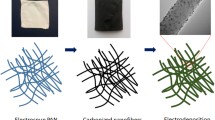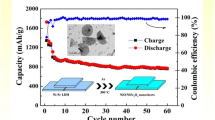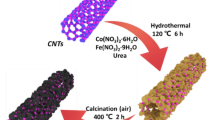Abstract
The unique crystal structure and multiple redox couples of iron titanate (Fe2TiO5) provide it a high theoretical capacity and good cycling stability when used as an electrode. In this study, the electrospinning method is employed to synthesize one-dimensional (1D) Fe2TiO5 nanochains. The as-prepared Fe2TiO5 nanochains exhibited superior specific capacity (500 mAh·g−1 at 0.10 A·g−1), excellent rate performance (180 mAh·g−1 at 5.00 A·g−1), and good cycling stability (retaining 100% of the initial specific capacity at a current density of 1.00 A·g−1 after 1000 cycles). The as-assembled Fe2TiO5/SCCB lithium-ion capacitor (LIC) also delivered a competitive energy density (137.8 Wh·kg−1) and power density (11,250 W·kg−1). This study proves that the as-fabricated 1D Fe2TiO5 nanochains are promising anode materials for high-performance LICs.
Graphic abstract





Similar content being viewed by others
References
Zhang Q, Uchaker E, Candelaria SL, Cao G. Nanomaterials for energy conversion and storage. Chem Soc Rev. 2013;42(7):3127.
Armand M, Tarascon JM. Building better batteries. Nature. 2008;451(7179):652.
Dunn B, Kamath H, Tarascon JM. Electrical energy storage for the grid: a battery of choices. Science. 2011;334(6058):928.
Amatucci GG, Badway F, Du Pasquier A, Zheng T. An asymmetric hybrid nonaqueous energy storage cell. J Electrochem Soc. 2001;148(8):A930.
Ding J, Wang H, Li Z, Cui K, Karpuzov D, Tan X, Kohandehghan A, Mitlin D. Peanut shell hybrid sodium ion capacitor with extreme energy–power rivals lithium ion capacitors. Energ Environ Sci. 2015;8(3):941.
Jezowski P, Crosnier O, Deunf E, Poizot P, Beguin F, Brousse T. Safe and recyclable lithium-ion capacitors using sacrificial organic lithium salt. Nat Mater. 2018;17(2):167.
Chen H, Dai C, Li Y, Zhan R, Wang MQ, Guo B, Zhang Y, Liu H, Xu M, Bao SJ. An excellent full sodium-ion capacitor derived from a single Ti-based metal-organic framework. J Mater Chem A. 2018;6(48):24860.
Naoi K, Ishimoto S, Miyamoto JI, Naoi W. Second generation ‘nanohybrid supercapacitor’: evolution of capacitive energy storage devices. Energy Environ Sci. 2012;5(11):9363.
Liu X, Li L, Li G. Partial surface phase transformation of Li3VO4 that enables superior rate performance and fast lithium-ion storage. Tungsten. 2019;1(4):276.
Chen S, Wang J, Fan L, Ma R, Zhang E, Liu Q, Lu B. An ultrafast rechargeable hybrid sodium-based dual-ion capacitor based on hard carbon cathodes. Adv Energy Mater. 2018;8(18):1800140.
Chen K, Yin S, Xue D. Active La–Nb–O compounds for fast lithium-ion energy storage. Tungsten. 2019;1(4):287.
Yang M, Zhong Y, Ren J, Zhou X, Wei J, Zhou Z. Fabrication of high-power Li-ion hybrid supercapacitors by enhancing the exterior surface charge storage. Adv Energy Mater. 2015;5(17):1500550.
Dai YQ, Li GC, Li XH, Guo HJ, Wang ZX, Yan GC, Wang JX. Ultrathin porous graphitic carbon nanosheets activated by alkali metal salts for high power density lithium-ion capacitors. Rare Met. 2020. https://doi.org/10.1007/s12598-020-01509-y.
An YB, Chen S, Zou MM, Geng LB, Sun Z, Zhang X, Wang K, Ma YW. Improving anode performances of lithium-ion capacitors employing carbon–Si composites. Rare Met. 2019;38(12):1113.
Chen Y, Murakami N, Chen HY, Sun J, Zhang QT, Wang ZF, Ohno T, Zhang M. Improvement of photocatalytic activity of high specific surface area graphitic carbon nitride by loading a co-catalyst. Rare Met. 2019;38(5):468.
Khomenko V, Raymundo-Piñero E, Béguin F. High-energy density graphite/AC capacitor in organic electrolyte. J Power Sources. 2008;177(2):643.
Lee WSV, Huang X, Tan TL, Xue JM. Low Li+ insertion barrier carbon for high energy efficient lithium-ion capacitor. ACS Appl Mater Interfaces. 2018;10(2):1690.
Mao Z, Wang H, Chao D, Wang R, He B, Gong Y, Fan HJ. Al2O3-assisted confinement synthesis of oxide/carbon hollow composite nanofibers and application in metal-ion capacitors. Small. 2020;16(33):2001950.
Zou K, Cai P, Wang B, Liu C, Li J, Qiu T, Zou G, Hou H, Ji X. Insights into enhanced capacitive behavior of carbon cathode for lithium ion capacitors: the coupling of pore size and graphitization engineering. Nano-Micro Lett. 2020;12(1):121.
Cai P, Zou K, Zou G, Hou H, Ji X. Quinone/ester-based oxygen functional group-incorporated full carbon Li-ion capacitor for enhanced performance. Nanoscale. 2020;12(6):3677.
Zou K, Cai P, Tian Y, Li J, Liu C, Zou G, Hou H, Ji X. Voltage-induced high-efficient in situ presodiation strategy for sodium ion capacitors. Small Methods. 2020;4(3):1900763.
Liu GY, Zhao YY, Tang YF, Liu XD, Liu M, Wu PJ. In situ sol-gel synthesis of Ti2Nb10O29/C nanoparticles with enhanced pseudocapacitive contribution for a high-rate lithium-ion battery. Rare Met. 2020;39(9):1063.
Zhu W, El-Khodary SA, Li S, Zou B, Kang R, Li G, Ng DHL, Liu X, Qiu J, Zhao Y, Huang Y, Lian J, Li H. Roselle-like Zn2Ti3O8/rGO nanocomposite as anode for lithium ion capacitor. Chem Eng J. 2020;385:123881.
Sun X, Radovanovic PV, Cui B. Advances in spinel Li4Ti5O12 anode materials for lithium-ion batteries. New J Chem. 2015;39(1):38.
Lou S, Zhao Y, Wang J, Yin G, Du C, Sun X. Ti-based oxide anode materials for advanced electrochemical energy storage: lithium/sodium ion batteries and hybrid pseudocapacitors. Small. 2019;15(52):1904740.
Guo S, Wang S, Wu N, Liu J, Ni Y, Liu W. Facile synthesis of porous Fe2TiO5 microparticulates serving as anode material with enhanced electrochemical performances. RSC Adv. 2015;5(126):103767.
França DT, Amorim BF, de Morais Araújo AM, Morales MA, Bohn F, de Medeiros SN. Structural and magnetic properties of Fe2TiO5 nanopowders prepared by ball-milling and post annealing. Mater Lett. 2019;236:526.
Tao T, Glushenkov AM, Rahman MM, Chen Y. Electrochemical reactivity of ilmenite FeTiO3, its nanostructures and oxide-carbon nanocomposites with lithium. Electrochim Acta. 2013;108:127.
Guan XF, Zheng J, Zhao ML, Li LP, Li GS. Synthesis of FeTiO3 nanosheets with 0001 facets exposed: enhanced electrochemical performance and catalytic activity. RSC Adv. 2013;3(33):13635.
Liu Q, He J, Yao T, Sun Z, Cheng W, He S, Xie Y, Peng Y, Cheng H, Sun Y, Jiang Y, Hu F, Xie Z, Yan W, Pan Z, Wu Z, Wei S. Aligned Fe2TiO5-containing nanotube arrays with low onset potential for visible-light water oxidation. Nat Commun. 2014;5(1):5122.
Min KM, Park KS, Lim AH, Kim JC, Kim DW. Synthesis of pseudobrookite-type Fe2TiO5 nanoparticles and their Li-ion electroactivity. Ceram Int. 2012;38(7):6009.
Kim D-H, Kim J. Synthesis of LiFePO4 nanoparticles in polyol medium and their electrochemical properties. Electrochem Solid-State Lett. 2006;9(9):A439.
Aricò AS, Bruce P, Scrosati B, Tarascon JM, van Schalkwijk W. Nanostructured materials for advanced energy conversion and storage devices. Nat Mater. 2005;4(5):366.
Bruce PG, Scrosati B, Tarascon JM. Nanomaterials for rechargeable lithium batteries. Angew Chem Int Ed Engl. 2008;47(16):2930.
Huang H, Yin SC, Nazar LF. Approaching theoretical capacity of LiFePO4 at room temperature at high rates. Electrochem Solid-State Lett. 2001;4(10):A170.
Wang Y, Wang Y, Hosono E, Wang K, Zhou H. The design of a LiFePO4/carbon nanocomposite with a core–shell structure and its synthesis by an in situ polymerization restriction method. Angew Chem Int Ed. 2008;47(39):7461.
Chen H, Wu Y, Duan J, Zhan R, Wang W, Wang MQ, Chen Y, Xu M, Bao SJ. (001) facet-dominated hierarchically hollow Na2Ti3O7 as a high-rate anode material for sodium-ion capacitors. ACS Appl Mater Interfaces. 2019;11(45):42197.
Pan H, Lu X, Yu X, Hu YS, Li H, Yang XQ, Chen L. Sodium storage and transport properties in layered Na2Ti3O7 for room-temperature sodium-ion batteries. Adv Energy Mater. 2013;3(9):1186.
Lu Y, Goodenough JB, Dathar GKP, Henkelman G, Wu J, Stevenson K. Behavior of Li guest in KNb5O13 host with one-dimensional tunnels and multiple interstitial sites. Chem Mater. 2011;23(13):3210.
Han JT, Liu DQ, Song SH, Kim Y, Goodenough JB. Lithium ion intercalation performance of niobium oxides: KNb5O13 and K6Nb10.8O30. Chem Mater. 2009;21(20):4753.
Zhang Y, Dong P, Zhao J, Li X, Zhang Y. Simple solution-combustion synthesis of Fe2TiO5 nanomaterials with enhanced lithium storage properties. Ceram Int. 2019;45(9):11382.
Liu J, Wang J, Xu C, Jiang H, Li C, Zhang L, Lin J, Shen ZX. Advanced energy storage devices: basic principles, analytical methods, and rational materials design. Adv Sci. 2018;5(1):1700322.
Ma SB, Nam KW, Yoon WS, Yang XQ, Ahn KY, Oh KH, Kim KB. Electrochemical properties of manganese oxide coated onto carbon nanotubes for energy-storage applications. J Power Sources. 2008;178(1):483.
Augustyn V, Simon P, Dunn B. Pseudocapacitive oxide materials for high-rate electrochemical energy storage. Energy Environ Sci. 2014;7(5):1597.
Chao D, Zhu C, Yang P, Xia X, Liu J, Wang J, Fan X, Savilov SV, Lin J, Fan HJ, Shen ZX. Array of nanosheets render ultrafast and high-capacity Na-ion storage by tunable pseudocapacitance. Nat Commun. 2016;7(1):12122.
Li S, Qiu J, Lai C, Ling M, Zhao H, Zhang S. Surface capacitive contributions: towards high rate anode materials for sodium ion batteries. Nano Energy. 2015;12:224.
Zhao C, Yu C, Zhang M, Huang H, Li S, Han X, Liu Z, Yang J, Xiao W, Liang J, Sun X, Qiu J. Ultrafine MoO2-carbon microstructures enable ultralong-life power-type sodium ion storage by enhanced pseudocapacitance. Adv Energy Mater. 2017;7(15):1602880.
Dong S, Shen L, Li H, Nie P, Zhu Y, Sheng Q, Zhang X. Pseudocapacitive behaviours of Na2Ti3O7@CNT coaxial nanocables for high-performance sodium-ion capacitors. J Mater Chem A. 2015;3(42):21277.
Liu H, Li Z, Sun H, Lu Q. Electrospun Fe2TiO5–TiO2@graphene nanofibers as highly durable insertion anode with enhanced lithium storage properties. Energy Technol. 2020;8(7):2000215.
Kim H, Cho MY, Kim MH, Park KY, Gwon H, Lee Y, Roh KC, Kang K. A novel high-energy hybrid supercapacitor with an anatase TiO2-reduced graphene oxide anode and an activated carbon cathode. Adv Energy Mater. 2013;3(11):1500.
Aravindan V, Sundaramurthy J, Jain A, Kumar PS, Ling WC, Ramakrishna S, Srinivasan MP, Madhavi S. Unveiling TiNb2O7 as an insertion anode for lithium ion capacitors with high energy and power density. Chemsuschem. 2014;7(7):1858.
Ye L, Liang Q, Lei Y, Yu X, Han C, Shen W, Huang ZH, Kang F, Yang QH. A high performance Li-ion capacitor constructed with Li4Ti5O12/C hybrid and porous graphene macroform. J Power Sources. 2015;282:174.
Aravindan V, Chuiling W, Madhavi S. High power lithium-ion hybrid electrochemical capacitors using spinel LiCrTiO4 as insertion electrode. J Mater Chem. 2012;22(31):16026.
Acknowledgements
This work was financially supported by the Natural Science Foundation of Jiangsu Province (No. BK20170549), the National Natural Science Foundation of China (No. 21706103), the China Postdoctoral Science Foundation (No. 2019T120393), the Postdoctoral Science Foundation of Jiangsu Province (No. 2019K295), the Young Talent Cultivation Plan of Jiangsu University and Jiangsu Provincial Program for High-Level Innovative and Entrepreneurial Talents Introduction.
Author information
Authors and Affiliations
Corresponding authors
Electronic supplementary material
Below is the link to the electronic supplementary material.
Rights and permissions
About this article
Cite this article
Kang, R., Zhu, WQ., Li, S. et al. Fe2TiO5 nanochains as anode for high-performance lithium-ion capacitor. Rare Met. 40, 2424–2431 (2021). https://doi.org/10.1007/s12598-020-01638-4
Received:
Revised:
Accepted:
Published:
Issue Date:
DOI: https://doi.org/10.1007/s12598-020-01638-4




